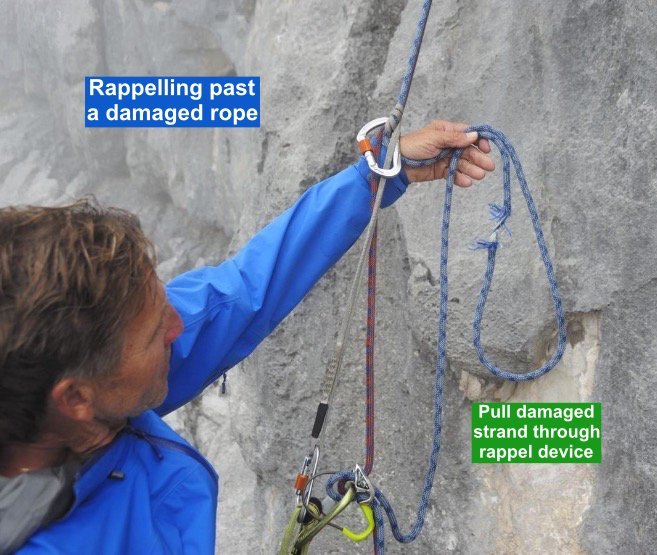How do you rappel past a damaged section of rope?
Premium Members can read the entire article here:
Note - This post discusses techniques and methods used in vertical rope work. If you do them wrong, you could die. Always practice vertical rope techniques under the supervision of a qualified instructor, and ideally in a progression: from flat ground, to staircase, to vertical close to the ground before you ever try them in a real climbing situation.
Photos and method in this post are from Walter Britschgi, @walterbritschgi, shared with permission.
Scenario: you’re rappelling down through some nasty loose rock.
During your rappel you kick some rocks loose.
One of them unfortunately hits your rope, damaging one strand.
Now, you need to finish your rappel, get past the damaged section of rope, and tie it off, so it's secure enough for you and your partner to continue going down.
How can you do this?
(Yes, it's a very unlikely situation, but if it happens, you’ll need to deal with it.)
Bigger picture, it's good practice when rappelling to look DOWN and be aware of what’s below you. Is the rope stuck in a crack? Are the ends on the ground? Do you need to pendulum to reach the next anchor? Or, in the case below, is the rope damaged?
Here’s another scenario where someone had to deal with this. (From Instagram. Sorry I don’t have the original post to offer credit.)
Here’s one method to rappel past a damaged section of the rope.
Stop a short distance above the damaged rope strand.
Go hands-free on your rappel. Let your autoblock take your weight. Tie a hard back up/catastrophe knot a few meters below in both strands, and clip it to your belay loop with a locker.
Add a friction hitch above your rappel device. A single length 60 cm sling is a good length for this.
Clip the friction hitch to your belay loop with a locker. Feed a little rope through your device until your weight goes onto the friction hitch.
Key move: Slide only the damaged strand of rope through your device. Once it's above you, tie a bight knot (overhand is fine) to isolate the damaged part of the rope.
Now is where it can get a little physical. Pull the slack rope through your device so you can reload both strands equally. (If it's really steep, you may need to add a second friction hitch as a foot loop.)
Put your weight back on your device, remove the friction hitch, untie the hard backup knot, and continue your rappel.
Check out the photo sequence below, courtesy of Walter Britschgi. (Note: recommended hard backup knot isn’t shown.)
Image: @walterbritschgi
Image: @walterbritschgi
Image: @walterbritschgi
Image: @walterbritschgi
Image: @walterbritschgi








